[In between my return from Afghanistan and when this was posted we got the awful news of the deaths of 4 Canadian servicemen, 7 Americans, and Calgary Herald reporter Michelle Lang who had traveled with us in Afghanistan. I post this because I believe they would want me to tell the story – particularly Michelle. But it makes the reality – and the gravity – of war far more personal to me. We mourn their passing.]
December 21, 2009 in the air from Toronto to Dubai
In the 5th grade we were asked to write stories about how we spent our Christmas vacations. Well mine’s a little late. But it’s a good story…..
I’m at 41,000 feet traveling at 557 mph on an Air Emirates plane from Toronto to Dubai. We started out last night in Ottawa. Our destination: Afghanistan.
I’m going with General Walter Natynczyk, the Chief of the Canadian Defense Staff, Greg Lacroix, the Chief Warrant Officer of Canadian Forces, Gary Lunn, the Minister of State for Sport, Laurie Hahn, the MP from Edmonton, a retired fighter pilot and the Parliamentary Secretary to the Minister of National Defense, comedian Mike MacDonald, and singer songwriter, Melanie Dekker.
Our plan is to spend a night in Dubai and then go on to Kabul. From there we will go to Kandahar City and then to several Forward Operating Bases (FOBs) on Christmas Eve and Christmas Day.
Why am I going? Two reasons: to honor the service and sacrifice of the Canadian and US troops who are so far from their homes and families during this Christmas season and to learn firsthand what is happening in the most important place in the world.
How do I feel about this? Excited, curious, and – to be honest – a little scared. Hopefully the last emotion is more melodrama than reality. I doubt the government would put the Chief of Defense Staff, two MPs, a beautiful singer and a famous comedian – let alone me – at unnecessary risk. At least I hope so.
One other thing keeps crossing my mind. My boots. I was told to leave the fancy stuff at home and to wear a pair of sturdy boots. I am wearing a pair I bought in 2007 to walk door-to-door in Iowa for Candidate Barack Obama. These boots were on my feet on some hot summer days, and while traipsing through the snow. They were there when people slammed doors in my face, when they called our now President foul names, when strangers invited me in to their homes to sit at the kitchen tables to talk about the future of my country, when people without much else told me that Barack Obama gave them hope. They were with me on that magical night in Des Moines, Iowa, when Barack Obama won the Iowa Caucuses. They were with me when he was sworn in as the 44th President of the Unites States. If anyone had told me when I bought these boots that they would have seen all that and then they would have gone on this journey to Afghanistan it would have been beyond comprehension.
So here’s the plan. I am going to keep this diary as I go along. Since I can’t communicate from here for security reasons, you might not see this for a while. But when I post it my hope is that other than correcting some spelling and grammar mistakes you will get what I wrote as I went along. When I started out this blog that’s what I promised. And this week it’s more important than ever that I stick to my plan.
Well – time to sign off and have my third meal (to go along with three movies and two operas) on this 12 hour flight. I can assure you I am not roughing it quite yet.
DJ
December 22, 2009 – Dubai, UAE
Everything in Dubai is huge. The airport is big and brand new. The highways have 7 or 8 lanes in each direction. And because they are new and because Dubai doesn’t have Canadian winters, the roads are perfectly smooth. Dubai has the world’s tallest building the Burj Dubai – 250 stories. I used to work in the Sears Tower in Chicago. This building is twice as tall.
DJ
12/23/09 – Dubai and Kabul, Afghanistan
In Dubai we got a refreshing (not) two hours of sleep before we were awakened at 2:15 am to have a quick shower and breakfast and then head over to the supply depot to get fitted with our helmets and body armor, aka “battle rattle.” The jacket weighs about 35 pounds. The helmet must weigh 8. I can tell you they are none too comfortable. Nor is the jacket easy to get on (though the military folks seem to do it with ease – I guess I need some practice). But I am VERY glad to have the protection.

The next stop was the airplane hangar where we got our military indoctrination in hurry-up-and-wait. But it gave us a chance to get to know one another and to take some pictures.
We boarded a C-130 Hercules for our three hour trip into Afghanistan. I had never been on a C-130 before. Let’s just say it’s functional. Probably would not be your plane of choice for a very long flight.
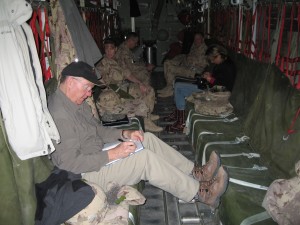
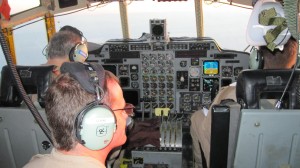
As we reached Afghan airspace we were told to don our flack jackets and helmets. From the air Afghanistan is a beautiful place. Snow covered rugged mountains. Fertile river valleys. Vast stretches of sand. On our descent into Kabul I was sitting with the crew in the cockpit and we were able to watch them go on to high alert for enemy fire. Fortunately there was none.
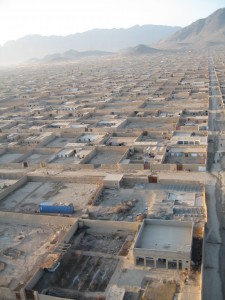
Nothing can prepare you for Afghanistan if you haven’t been there. It is extremely poor (the 5th poorest country in the world). It has been decimated by 30 years of war. There are troops with automatic weapons – and more – everywhere. You drive through Afghanistan checkpoints, Coalition military checkpoints, private security checkpoints sometimes only a few feet apart. There are sandbags and concrete barriers everywhere. Off the main roads – and sometimes on them – there are extreme speed bumps and concrete barriers that force you to drive in zigzags to slow down. There is razor wire everywhere. The tour consisted of stories of IED and suicide bombings at the various places we drove past.
Amid all this were young children playing and dogs wandering around. It was this odd mosaic of ancient, destroyed, poor, carefree, fortifications, and ultra modern technology and weaponry. On top of it all, is dust. Lots of it. I think most is from blowing sand. But some is from the fires people use in the winter to stay warm and to cook. I guess Copenhagen is not their biggest concern over here at the moment.
The day was filled with briefings by US and Canadian military leaders as well as by officials from the US and Canadian embassies in Kabul. A few highlights:
• The headline is that the only way we will be successful here is if the Afghan people want it as much or more that we do. And a critical component of that is whether the Afghan people truly believe we will win. If they do they will side with us. If not they will be pragmatic and side with the Taliban. As in sports – no one likes a loser (unless you’re a Cubs fan). That is particularly true when the lives of your family are at stake.
• The Taliban are a skilled adversary. They understand the history and the strategy of insurgency. They adopt their tactics to ours. To harbor any sense that it is a rag-tag bunch is to make the first mistake of war – underestimating the enemy.
• The Taliban are not generally liked by the Afghan people. This is not perceived as a war of national liberation. This is one of our greatest assets in this war. This is not Mao in China or Castro in Cuba.
• There are signs of hope. But the jury is still out. For the first time ever, the Afghan army is exceeding their enlistment and retention targets. This is no doubt due to a variety of factors, including President Obama’s speech which has hopefully instilled a sense of urgency in the Afghan people and their leaders. It is also due to the fact that army salaries have been increased so that an Afghan can support his family on what he earns. Hopefully this trend will continue.
• Corruption is a huge problem. While we can never impose our standards on Afghanistan, there is a lot of room for improvement in order to make the situation acceptable to us and to the Afghan people who (unless they are the beneficiaries) are just as outraged as we are. Perhaps more. The stolen money was destined to build a school or a hospital in their neighborhood.
• The troops are magnificent. Brave, proud, professional, committed. What you hear every day is true. These men and women are our finest.
After the briefings there was a show for the Canadian Forces in Kabul. Then we had dinner and a lively conversation at the Canadian Ambassador’s home. We were joined by representatives from the United States, Canada, the UK and the Netherlands. After that we got some much needed sleep.
DJ
12/24/09 – Kandahar
We left Kabul on a beautiful morning. It’s hard to believe such bad things can happen in a place so pretty.

When we arrived we got a tour of the Kandahar Air Field (KAF). It’s a not so small city with troops from about 18 International Security Assistance Force (ISAF) coalition partners, including many from Canada. The Kandahar region Task Force, including US and other coalition forces, is under the command of Canadian Brig. Gen. Daniel Menard, who spent the day traveling with us.
We had several briefings about the military and political situation on the ground. And I had the chance to meet with several groups of the US military, including a group from the legendary 82d Airborne.

After our briefings we toured the famed Kandahar “Boardwalk,” which is the recreational area on at KAF. People were definitely in the Christmas spirit. Including those who were hanging around the most famous Tim Horton’s in the world!
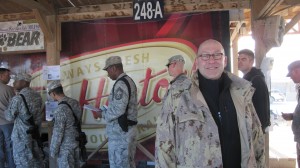

With General Natynczyk we came upon a simple memorial to the fallen in Afghanistan. Bronze plaques with each soldier’s name, birth date, the day he or she died and the regiment. It – of course – reminded us of why we were there. But for me I was most touched by the fact that General Natynczyk could tell us about each of the fallen. Who they were. Stories about their lives or their families. The circumstances of their deaths. The Canadian Forces and the Canadian people are fortunate to have a leader who is not only so strong and wise but also so compassionate.

We then went for a tour of the KAF hospital facility. Like much in Afghanistan, it was both wonderful and awful. Wonderful in that it was a first class facility (soon to be replaced with an even better and more permanent one) with dedicated doctors nurses and other professionals. Wonderful in that it takes in children from Kandahar. There were several kids who will probably recover from illnesses and injuries but who would probably not have survived given the abject lack of health care in Afghanistan. We saw one young child who had swallowed kerosene. He was brought to the hospital by his mother. Absent this facility he would almost certainly have died. This is the kind of thing we should all be very proud of. And it is exactly the kind of experience that will sway popular support and might make it possible for the coalition to win this war.

But the hospital was also awful in that we saw the price of war on our soldiers and Afghan civilians. Perhaps most sobering was an 11 year old Afghan boy who had lost several fingers in an IED blast. The doctors told me they believed he was probably planting the device when it accidentally exploded. When I asked if it was unusual for an 11 year old child to be recruited by the insurgents I was told it was common. “Kids are the cheapest form of labor for the Taliban.”
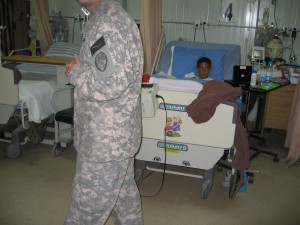
It was not all joy on Christmas Eve in Afghanistan. Yesterday, Lt. Andrew Nuttall of the Canadian 1st Battalion, Princess Patricia’s Canadian Light Infantry was killed by an IED. One of the people I spoke with during my visit to the hospital was the Afghan interpreter who was with Lt. Nuttall during his mission. He was pretty banged up. But he told me that they were going on a patrol to clear a group of houses. While they were in one of the houses an IED exploded, killing Lt. Nuttall and injuring the interpreter.
After we left the hospital we went to the Ramp Ceremony to honor Lt. Nuttall. It was quite emotional as his comrades from so many ISAF countries paid their final respects as his casket was carried onto an awaiting C-130, accompanied by a lone bagpiper. I will not soon forget Lt. Nuttall or that moment.
After the ceremony we got on a Chinook helicopter for a trip to the Canadian Forward Operating Base at Ma’sum Ghar. Chinooks are those huge helicopters with two large rotors. If you haven’t been in one I can assure you that they are not configured for comfort. But they are workhorses and the military loves them.

This flight may have been normal for Afghanistan. But the circumstances were a little unnerving for me. There are two side doors and a large rear cargo hatch. They were all open so machine gunners could hang out and watch for insurgent activity. And there were helicopters following us for cover. We flew a few feet above the ground.

Anyway, we made it safely to Ma’sum Ghar for a Christmas Eve Dinner and a show for the troops. The dinner was served by General Natynczyk, Chief Warrant Officer Greg Lacroix, Minister Lunn, MP Hahn, and me.



During dinner I had a great conversation with three Canadian soldiers. They talked about how proud they were of what they were doing and how they didn’t want to be anywhere else – even on Christmas Eve. One told me “this is what we trained for.” One thing I can say without fear of contradiction is that morale among Canadian (and American) troops could not be better. It seemed like the more difficult the place they were stationed the more committed they were to their mission.
Then Mike McDonald and Melanie Dekker put on one of their eight shows in 48 hours. Mike is a great Canadian comic who was back in Afghanistan for his second Christmas. His jokes brought smiles and laughter to people who deserve nothing less and reminded me of the character and humanity of our brave soldiers.
Melanie is a great singer and songwriter. Her performances wowed the troops. And her looks prompted several proposals of marriage along the way.


But more than just great performances they are great people and great Canadians. They came here because they wanted to show their support and appreciation to the troops. They performed on makeshift stages, on piles of rock, with failing PA systems, and often with no sound systems at all. Regardless of the physical circumstances they were always great.
At Ma’sum Ghar Minister Lunn began what became a tradition at each stop. When he found out he was coming on the trip he called the Bay Company and asked them to donate 3000 pairs of those red Canadian Olympic mittens for the troops. Then he talked Air Canada in to shipping them to Afghanistan for free. Each night Gary would distribute the mittens with great flourish. Were they appreciated by the troops? The photo says it all!

Mike McDonald did manage to point out, however, that while it was generous of the Bay Company to donate the mittens and while it was nice of Air Canada to deliver them for free, he was not sure the thing the troops needed most in Afghanistan were mittens. Made it kind of hard to shoot!
After the Ma’sum Ghar show we had a special moment. General Natynczyk took us up to the top of a mountain near the camp where a pair of sergeants were manning a lookout on top of a tank on Christmas eve (so their troops could celebrate). We went up to wish them a merry Christmas and to give them their mittens.
DJ
12/25/09 – Christmas Day at FOB’s in Afghanistan
After spending the night in Ma’sum Ghar we assembled for a team photo and then got back in the Chinook, with machine gunners and helicopters, for the first of five stops at additional FOBs around Kandahar.

Everywhere the routine was the same. The troops were honored to meet Gen. Natynczyk. Melanie and Mike entertained and they loved the mittens.
At FOB Wilson we saw firsthand the level of cooperation between our two countries. Canadian and US troops were working and serving side-by-side. Everyone I talked with complimented the troops from the other country.
One other stop is worth a shout out. At FOB Jelewar we watched some calibration and practice by Canadian troops firing a M777 155 mm howitzer. That weapon can fire a 100 lb. shell 30 KM with pinpoint accuracy. When it fires you can watch the shells streak into the horizon. General Natynczyk let us each take a turn letting her rip. Mike McDonald went first. I was next.

After the FOB’s we arrived at the final stop of the night, the Provincial Reconstruction Team (PRT) at Camp Nathan Smith. PRT’s are a key component in Gen. McChrystal’s new strategy of protecting the population centers and then showing the Afghan people that there is a better way. They organize and finance projects from small efforts like drilling wells to mega undertakings like Canada’s rebuilding of the Dahla Dam, which will allow for irrigation of much of the Kandahar province. The PRT in Kandahar is supervised by a Canadian. His deputy is an American and his team is made up of Canadians and a growing group of Americans.
At the PRT I had a “small-world” experience. In a village outside Kandahar City 10,000 km from my home in Chicago I ran into my own Congressman, Mark Kirk, from the Illinois 10th Congressional District. Congressman Kirk is a member of the Army reserves. He was in Kandahar for several weeks of active duty. We had a great discussion about the situation on the ground in Afghanistan (and Illinois politics).
DJ
12/26-27/09 – The trip back to Ottawa
We spent the night at the PRT and then began retracing our steps. We took a Chinook to KAF where we met with more Canadian forces. Then we got on a C-130, along with a group of Canadian forces who were on their way to take leave, and flew to Dubai where I was able – mercifully – to take a much needed shower.
After a trip into the city (the size and scope of Dubai is a shocker to anyone who hasn’t been there) we had another great Canadian Forces dinner. Afterwards, Mike and Melanie put on their last show. We then flew to Frankfurt where we split up for various flights home. It felt like the last day of school when we said our goodbyes. I promised to try to “reunite the band.” This time on US soil at my house in Ottawa for our 4th of July celebration.
A few closing observations. I went to Afghanistan with two goals in mind:
• To honor the service and sacrifice of the Canadian and American troops; and
• To learn more about the situation on the ground.
I did my best to honor the troops and I will continue to do so. I also learned a lot.
I learned about the bravery, the dedication, the professionalism, and the human decency of the troops.
I learned that the United States and Canada continue their tradition – which began generations ago – of defending North America shoulder–to-shoulder. We cooperate at every level. From cooks to special ops to Generals.
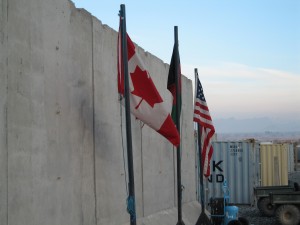
I learned that we won’t win this war by killing people. While we need to establish a secure environment in the key population centers to allow the civilian process to function, we will only succeed if we show the Afghans that ours is a better way; that they can earn a living and feed their families by supporting us and by rejecting the Taliban.
I learned that ultimately this has to be the Afghan’s fight. That they have to want peace and security as much as we do. They must stand up a government that has the support of the Afghan people. I am optimistic we will succeed in our part – securing the civilian population centers and improving opportunities for the Afghan people. The jury is – quite honestly – still out on whether the Afghans will take over their own defense, limit the corruption, and create a government that has the confidence of their people. One the Afghan people will fight for and – if necessary – die for.
And I learned that success in Afghanistan is inextricably tied to Pakistan which is, in turn, tied to regional issues spanning from India to Iran to China and Russia.
2009 was a tough year in this part of the world. 2010 will be critical. I am hopeful.
Last, but certainly not least, I want to thank Gen. Natynczyk, Minister Lunn, MP Hahn and the rest of the Canadian Forces for providing me with this opportunity and for making me feel a part of the same team in the same way our US and Canadian forces are part of the same team. It was an extraordinary journey. And the best Christmas ever!


DJ





























 Post Entries (RSS)
Post Entries (RSS)